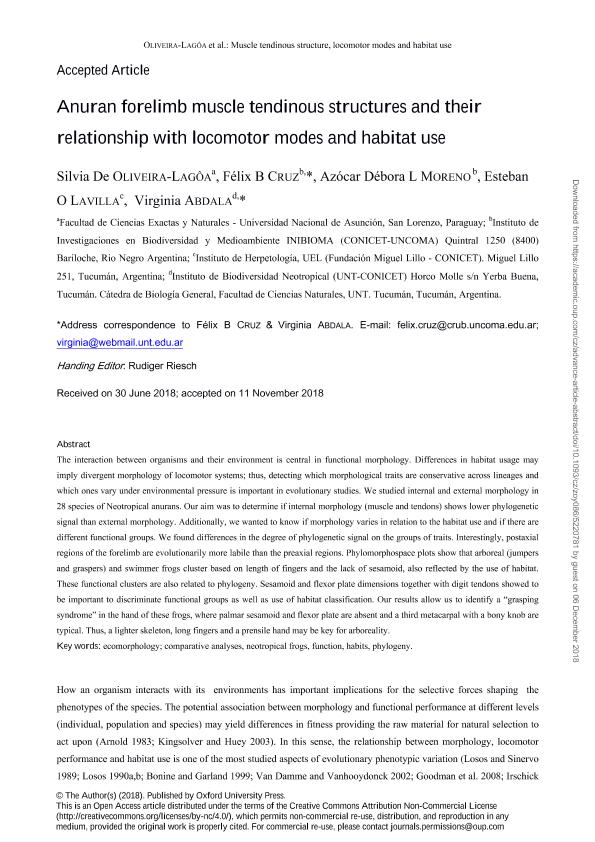Artículo
Anuran forelimb muscle tendinous structures and their relationship with locomotor modes and habitat use
De Oliveira Lagôa, Silvia; Cruz, Felix Benjamin ; Moreno Azócar, Débora Lina
; Moreno Azócar, Débora Lina ; Lavilla, Esteban Orlando
; Lavilla, Esteban Orlando ; Abdala, Virginia Sara Luz
; Abdala, Virginia Sara Luz
 ; Moreno Azócar, Débora Lina
; Moreno Azócar, Débora Lina ; Lavilla, Esteban Orlando
; Lavilla, Esteban Orlando ; Abdala, Virginia Sara Luz
; Abdala, Virginia Sara Luz
Fecha de publicación:
11/2018
Editorial:
Oxford Academic
Revista:
Current Zoology
ISSN:
1674-5507
Idioma:
Inglés
Tipo de recurso:
Artículo publicado
Clasificación temática:
Resumen
The interaction between organisms and their environment is central in functional morphology. Differences in habitat usage may imply divergent morphology of locomotor systems; thus, detecting which morphological traits are conservative across lineages and which ones vary under environmental pressure is important in evolutionary studies. We studied internal and external morphology in 28 species of Neotropical anurans. Our aim was to determine if internal morphology (muscle and tendons) shows lower phylogenetic signal than external morphology. In addition, we wanted to know if morphology varies in relation to the habitat use and if there are different functional groups. We found differences in the degree of phylogenetic signal on the groups of traits. Interestingly, postaxial regions of the forelimb are evolutionarily more labile than the preaxial regions. Phylomorphospace plots show that arboreal (jumpers and graspers) and swimmer frogs cluster based on length of fingers and the lack of sesamoid, also reflected by the use of habitat. These functional clusters are also related to phylogeny. Sesamoid and flexor plate dimensions together with digit tendons showed to be important to discriminate functional groups as well as use of habitat classification. Our results allow us to identify a ?grasping syndrome? in the hand of these frogs, where palmar sesamoid and flexor plate are absent and a third metacarpal with a bony knob are typical. Thus, a lighter skeleton, long fingers and a prensile hand may be key for arboreality.
Palabras clave:
comparative analyses
,
rcomorphology
,
neotropical frogs
Archivos asociados
Licencia
Identificadores
Colecciones
Articulos(UEL)
Articulos de UNIDAD EJECUTORA LILLO
Articulos de UNIDAD EJECUTORA LILLO
Citación
De Oliveira Lagôa, Silvia ; Cruz, Felix Benjamin; Moreno Azócar, Débora Lina; Lavilla, Esteban Orlando; Abdala, Virginia Sara Luz; Anuran forelimb muscle tendinous structures and their relationship with locomotor modes and habitat use; Oxford Academic; Current Zoology; 65; 5; 11-2018; 1-10
Compartir
Altmétricas



